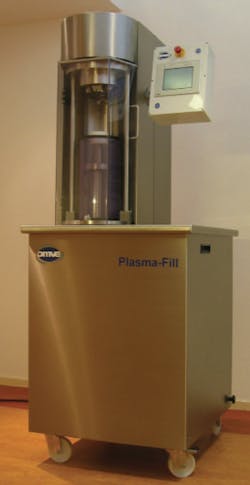Pneumatics Makes for Clean Automation in the R&D Lab
When officials at OVME Netherlands decided on the best pneumatic solution for a new plasma-fill machine, they partnered with Norgren to deliver the reliability and flexibility they needed. Founded in 1980 OMVE, Schalkwijk, Netherlands, has established a reputation as one of the world leaders in carbonizing products. OMVE has close partnerships with leading industrial R&D companies and science institutes to deliver innovative new products for the food processing and testing industries.
OVME developed new plasma fill equipment to address critical requirements within test laboratories. When processing products in a laboratory, a constant risk exists that contamination can be introduced into the foodstuff being processed. This is mainly due to the fact that the machines used are not fully aseptic. The new OMVE Plasma-Fill changes this. It is now possible for research and development departments to produce fully packaged samples that match the aseptic capability of production machines at a fraction of the cost.
An open-and-shut case
The Plasma-Fill allows for the aseptic filling of a liquid in a fully sterilized package. Having placed the package by hand into the filling closing area, oxygen is then removed from the air. Next, the package is sterilized with the use of cold plasma. The gas in the chamber directly above the package is kept completely sterile with plasma also.
The required volume within the chamber is filled up with nitrogen, then the package is filled. Operators can adjust the pressure within the chamber to that required, and then the package is sealed. For absolute peace of mind the gas in the chamber is circulated over a high efficiency particulate arrestance (HEPA) filter. HEPA filters were developed to remove particles from the air that might otherwise pose a health hazard. HEPA filters must be certified 99.97% efficient in capturing particles 0.3 μm in size. The overall process is monitored by a PLC and operator touch screen interface.
The majority of the automation within the machine is undertaken with the aid of Norgren pneumatic solutions. OMVE prefers pneumatics for the automation within the Plasma Fill due to the flexibility and reliability that this technology delivers. Pneumatic drives make it easy to adjust the drive power required very easily; all the operator has to do is simply adjust air pressure viaregulators. This simplicity means there is no need to install a wide variety of safety features to limit the force of the actuators employed, as with an electromechancial system. Officials at OMVE found this solution minimizes product loss and reduced machine failures.
The Plasma Fill uses three different methods to close the filled sample container. One method calls for a riveted connection with metal packing, another uses a screw cap on a plastic bottle, and the third has a crown cork on a glass bottle. A variety of different forces and movements is required for all of these closing systems.
In conjunction with engineers from Norgren, OMVE engineers found that the best solution for the closing system was to use eight of Norgren’s V60 series air valves. These valves operate a pneumatic motor with two different torque settings to rivet the metal packing and drive home the riveting tool during the closing process. Each V60 valve has its own Norgren R72 series regulator that allows the operator to set the required pressure to that needed to apply the proper torque and force by air motors and cylinders, respectively.
A pair of parallel mounted Norgren cylinders fully closes the pressure chamber contained within the Plasma-Fill. These cylinders counteract the force caused by the pressure in the chamber. Another Norgren actuator moves the packaging into position before and after the filling operation. Many more actuators are used to move the plasma and filling device toward the package and to retract it back after sterilization and filling.
The Plasma Fill has been nominated for the “Metaalunie Innovation award.” This nomination recognizes the machine’s innovations both in design and in operation. Its overall success is a combination of OMVE’s know-how and experience in the area of food processing and testing and Norgen’s knowledge of solutions that will make a real difference in applications of this type.
Click here to watch a video describing Norgren's V60 valve.



